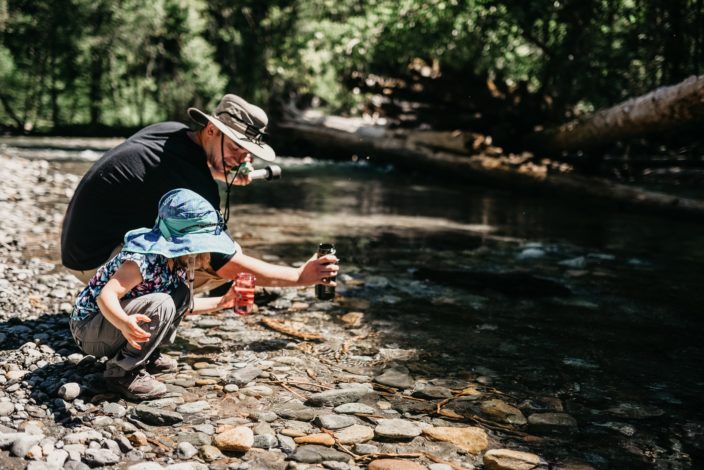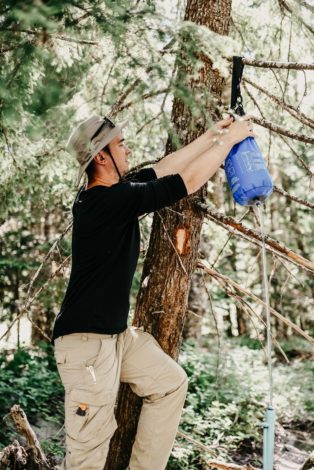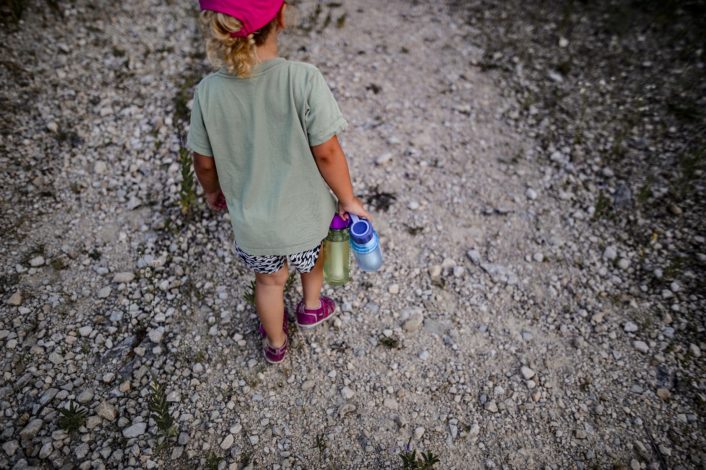Types of Water Treatment for Hiking and Backpacking
 I’m a big believer that some of the best family memories occur outside. When I think back to my own childhood, the memories that come the quickest involve family camping trips, S’mores by the fire my siblings and I helped build, long hikes in the woods and boiling endless pots of water to kill the “water bugs” as my dad called them. Yep, even 20 years ago we were worried about water pathogens. This has become a problem with natural water sources, but there are various water treatment methods that are currently available to keep you and your family safe so you can focus on making outdoor memories rather than suffering through bad ones.
I’m a big believer that some of the best family memories occur outside. When I think back to my own childhood, the memories that come the quickest involve family camping trips, S’mores by the fire my siblings and I helped build, long hikes in the woods and boiling endless pots of water to kill the “water bugs” as my dad called them. Yep, even 20 years ago we were worried about water pathogens. This has become a problem with natural water sources, but there are various water treatment methods that are currently available to keep you and your family safe so you can focus on making outdoor memories rather than suffering through bad ones.
Why Can’t We Just Drink the Water from Natural Sources?
With environmental decline, along with an increase of livestock, human traffic on trails and wild animals near water sources, water quality (even in the more remote areas) is declining. Even if water from natural sources looks clean and clear and you can see every tiny organism and rock on the bottom of the water bed, it could still be harboring pathogens such as protozoa, bacteria and viruses that can make you and your family very sick. These pathogens can cause a myriad digestive problems (such as diarrhea, vomiting, etc.) or worse, depending on the type of pathogen you are dealing with. As a result, studies performed by the Center for Disease Control and Prevention conclude that you should always filter and disinfect water from natural sources.Is there a Difference Between Water Purification and Filtration?
While both purification and filtration methods can remove pathogens from water, they do so in different ways. Filtration techniques provide a barrier that blocks most pathogens while still allowing water to pass through. The one downside is the fact that while filtration may work well against bacteria and protozoa, they don’t always stop tiny viruses from slipping through with the water. That being said, filtration techniques are the most widely used by backpackers in the United States because water-borne viruses in natural water sources are extremely rare in the Unites States. If you plan to use a natural water source while hiking, camping or backpacking internationally (or if you want to be extra cautious in the U.S.), purification is the method of choice. It gets rid of or immobilizes most (if not all) water-borne pathogens, including viruses that are too small to be caught through filtration methods. While some filtration methods also purify the water, purification is mainly done through sterilization (think boiling) or chemical methods.What are Some Water Treatment Systems Available?
Not all treatment systems are created equal, and all have pros and cons associated with them. Below is a list of some common methods along with the advantages and drawbacks to each method. I have broken them into two categories based on activity, but there can be crossover depending on the situation.Camping and Backpacking: Most quantity of water needed and time isn’t a factor
1. Boiling (purification)Pros: The most low-tech and easy technique of all those mentioned here is to boil your water. Bring it to a “rolling boil” for a minute (or three minutes at altitudes above 6,500 ft.). This is also cost-effective (for the most part) since you likely already have a cook-set with you.
Drawbacks: Fuel is needed, whether in the form of a gas canister or wood. Gas can be heavy, and if it runs out, there is no way to replenish it when you’re far away from civilization (this is especially an issue where open fires are not allowed). And between bringing the water to a boil and waiting for it to cool down enough to drink, it is a slow treatment option!
2. Pump (most use filtration, but a few also purify)Pros: There are generally three main components to a pump: the filter, the hand-held pump and the tubes. The intake tube (or “dirty” tube) is placed in the water source while the outlet tube (or “clean” tube) is placed into your water container. You then go to work pumping water from the source through the filter and into your container. Or better yet, getting the kids involved could make this a fun and educational experience for them (if you play your cards right and call it a game or competition, you may not have to do any of the pumping yourself!). This technique is fairly quick depending on how fast you are pumping and works well in shallow water. It also works well for both single and group use and can filter out sediment so your water isn’t gritty.
Drawbacks: Pumping can be tiring, especially if you are pumping water for a group. They are bulky, with the tubes and filter taking up quite a bit of space. This is no big deal if you are car camping in the backcountry, but it can add quite a bit of weight and take up precious room while backpacking (especially if you are carrying the extra gear of your little ones during a family backpacking trip).
3. Chemical Water Treatment (purification)Pros: This is what many consider the “old-school,” yet still highly effective method of treating water. You simply drop a tab or drops into your water container, shake it around, and then wait the allotted time for the chemical to kill the pathogens. They are lightweight, inexpensive and super easy to use. If you choose a different method of water treatment, many outdoor experts recommend carrying this treatment option as a backup just in case your equipment malfunctions. Due to the drawbacks of iodine tablets (terrible taste, danger to pregnant mamas and those with thyroid problems, ineffectiveness against the Cryptosporidium parasite, etc.), Chlorine dioxide is generally the chemical method of choice.
Drawbacks: It takes anywhere from 30 minutes to four hours for the chemical to work. Large amounts of water will require a higher quantity of the chemical, which can be a problem if you didn’t pack enough water with you.
4. Gravity (filtration)Pros: Here is a method that works very similar to pump filters, but it lets gravity do the work for you. Most models come with two water bladders (one for the “dirty” water and one for the “clean” water that is filtered) along with a series of hoses and the filter unit. You fill the “dirty” bag with water from the natural source and hang it on a tree or tall rock before hooking up the hoses and filter along with the “clean” water bag at the bottom. You can then sit back and relax, set up camp, play some family games, practice some yoga, whatever you want while you let gravity filter your water at a pretty fast rate (around 2 liters per minute). Gravity filters, like the Lifestraw Mission, do not need a power source as well so you can use this anywhere.
Drawbacks: Could be more difficult in shallow water as you need to fill the water bladder.

Hiking – Requires lower volumes of water, but need water fairly quickly
1. Squeeze (filtration)Pros: Do your kids love to squeeze things (my little dude is all about the squeeze pouches, squeeze glue, squeeze mud, anything squeezable)? If so, this may be a great option for you! The squeeze filter (like the Lifestraw Flex) consists of a bag, the compact filter unit, and whatever you want to squeeze the water into (whether it be another bag or straight into your mouth). You simply fill the bag with water from the source and squeeze it through the filter. They are easy to use, lightweight, and provide water immediately. And that’s on top of being fun for the kids to use! Filters like the Lifestraw Flex protect against microplastics, parasites, bacteria, and reduces chemicals and heavy metals like lead.
Drawbacks: They can get clogged quickly depending on the water source, requiring cleaning or backflushing. They are not ideal for large quantities of water, making this a more appropriate treatment option for hiking as opposed to camping or backpacking.
2. Water Bottle Filters (filtration or purification depending on brand)Pros: Water Bottle Filters (filtration or purification depending on brand): These bottles have built-in filtration or purification elements. Some use the suction you provide when you sip from the bottle while others work like a coffee press or use UV light to filter/purify your water. They are easy to use for the whole family, and tend to be reasonably priced. The new Lifestraw Play is designed for kids with it’s two stage filtration and leak proof design. The lid is a great feature to keep dirt and sand out of straw. For an adult option, check out the Lifestraw Go.
Drawbacks: As with the squeeze filters, they may get clogged and require cleaning while on the trail. The Play and Go can be cleaned by blowing air through the mouthpiece until water drains out of the bottom of the filter to backflush it and prevent it from clogging. The amount of water you filter is limited by the size of the bottle, making this method better suited for long family hikes near water sources as opposed to camping/backpacking.
3. Straw (mainly filtration, though some high-end models offer purification)Pros: This method is similar to the squeeze and water bottle filters except instead of attaching to a pouch or a bottle, the filter is placed directly into a water sources and you suck through it like a straw. These are very lightweight and fairly small, so they won’t take up a large amount of space in your bag.
Drawbacks: There is no way to store the water, making this better suited for a hike that follows a water source (which is also why it is not ideal for camping or backpacking). Many reviews report that it can be difficult to suck water through the straw, making this not a good option for kids. They can get clogged, forcing you to clean it on the trail. It’s just plain awkward to hunker down with your face almost in the water every time you want to take a drink. I usually keep one in my pack as a backup, but it is not my first option for filtering my water.
 4. Ultraviolet Light Purifiers (purification)
4. Ultraviolet Light Purifiers (purification)
Pros: You simply place the probe of this pen-like device into the container of water you want to treat and swirl it around for a specific amount of time (usually around 60 seconds) to neutralize the pathogens in it. Unlike most filters, you never have to clean or replace any parts on this device (other than maybe the batteries), and it is very easy to use.
Drawbacks: This unit requires batteries, and one of the chief complaints from users is that it goes through battery-power quickly. Since there are no parts that can be cleaned or fixed, you run the risk of malfunction (which is why it is always good to bring a back-up treatment method!) Since you are not filtering your water, sediment found in the water has nowhere to go. This makes the unit take longer to purify the water, and means that you will be ingesting that sediment unless you first filter the water with another method. Multiple treatments are required to purify larger amounts of water, and if the water sits around for a while, the neutralized pathogens may become active again (making this more suited to hiking vs. camping and backpacking).
With so many water treatment options, it may be difficult to choose which ones to try out on your next adventure. Does your family have a favorite method of water treatment while on the trail or at the campsite? Let us know in the comments below! Photos by Deanna Curry and Laura Castro.Read More:
This post is sponsored by Lifestraw. Stay hydrated wherever you go, because adventures await! Get ready for a family-friendly summer. LifeStraw has some great new gear especially designed for kids to take your explorations to the next level. LifeStraw filters remove bacteria, parasites, microplastics, and chemicals from water, making it safe to drink. The new LifeStraw Play is the first water filter for children with this level of protection. Kids can simply fill their bottle at a water fountain, lake, stream or any other freshwater source and enjoy clean, great-tasting water! Check it out here and use code HIKEIT20 at checkout for 20% off through the end of July.Related Content




Comments